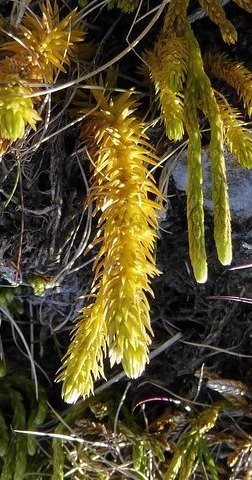Hickey's tree club-moss
(Dendrolycopodium hickeyi)

Description
Dendrolycopodium hickeyi, synonym Lycopodium hickeyi, known as Hickey's tree club-moss or Pennsylvania clubmoss, is a North American species of clubmoss in the family Lycopodiaceae. It is native to eastern and Central Canada (from Newfoundland to Ontario with isolated populations in Saskatchewan) and the eastern and north-central United States (from Maine west to Minnesota and south as far as Tennessee and North Carolina). The genus Dendrolycopodium is accepted in the Pteridophyte Phylogeny Group classification of 2016 (PPG I), but not in other classifications, which submerge the genus in Lycopodium. Dendrolycopodium hickeyi is very similar to D. obscurum except for a few minor but consistent features: side shoots round rather than flat in cross section, leaves all the same size. The oldest name for the taxon is Lycopodium obscurum var. isophyllum. In elevating the plants from varietal level to species level, Wagner et al. opted to forgo the common (but not mandatory) custom of using the old varietal epithet as the new species epithet. They chose instead the name Lycopodium hickeyi while acknowledging the old varietal name as synonym. Lycopodium (from Greek lykos, wolf and podion, diminutive of pous, foot) is a genus of clubmosses, also known as ground pines or creeping cedars, in the family Lycopodiaceae. Two very different circumscriptions of the genus are in use. In the Pteridophyte Phylogeny Group classification of 2016 (PPG I), Lycopodium is one of nine genera in the subfamily Lycopodioideae, and has from nine to 15 species. In other classifications, the genus is equivalent to the whole of the subfamily, since it includes all of the other genera. More than 40 species are accepted. They are flowerless, vascular, terrestrial or epiphytic plants, with widely branched, erect, prostrate, or creeping stems, with small, simple, needle-like or scale-like leaves that cover the stem and branches thickly. The leaves contain a single, unbranched vascular strand, and are microphylls by definition. The kidney-shaped (reniform) spore-cases (sporangia) contain spores of one kind only, (isosporous, homosporous), and are borne on the upper surface of the leaf blade of specialized leaves (sporophylls) arranged in a cone-like strobilus at the end of upright stems. The club-shaped appearance of these fertile stems gives the clubmosses their common name.
Taxonomic tree:







